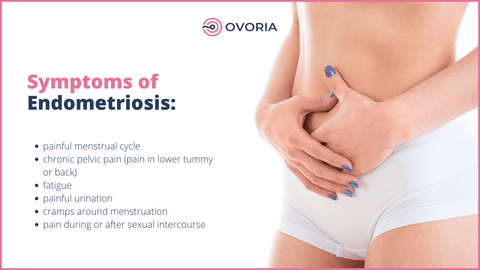Endometriosis - Symptoms, Causes, Possible Treatments
Infertility is a problem that has risen in numbers over the past decades. According to the World Health Organization (WHO) approximately 1 in 10 women of reproductive age are affected by endometriosis. Additionally, about 90% of these women report that the condition has a negative impact on their life, work, relationships, and mental health, further illustrating the severity of endometriosis. Thus, this article provides an extensive overview over the condition's symptoms, causes, possible treatments, and more.

What is Endometriosis?
Endometriosis is a condition where endometrial tissue similar to the lining of the uterus grows outside the uterus. This results in the development of inflammation and the formation of scar tissue on or around the ovaries, fallopian tubes, and the tissue lining pelvis. In rare instances, endometriosis can also occur in other body regions.
We distinguish between several types of endometriosis;
- Superficial Peritoneal Lesions: this type of endometriosis is the most common. The lesions are found in the peritoneum, the connective tissue that binds the pelvic cavity and abdominal wall.
- Ovarian Endometriomas: fluid-filled cysts are also known as chocolate cysts. These cysts are located in the ovaries and can damage healthy tissue.
- Deep Infiltrating Endometriosis: lesions that are usually located under the peritoneum, resulting in severe pain.
Endometriosis stages
In addition to the various types of endometriosis, the disease can be classified into four different stages. These are;
- Minimal (Stage 1): minimal manifestation with few superficial implants.
- Mild (Stage 2): mild manifestation with more and deeper implants
- Moderate (Stage 3): moderate manifestation with many deep implants, small cysts on one or both ovaries, and filmy adhesions are present.
- Severe (Stage 4): Severe manifestation with many deep implants, large cysts on one or both ovaries and many adhesions.
The stages are determined by the locations of endometrial tissue within the body, the extent of its spread, and the volume of tissue present in those specific areas.

Symptoms of Endometriosis
The symptoms of endometriosis can vary and depend on the type and stage of the disease. While some women only experience mild symptoms, others are heavily affected. Some of the most common symptoms of endometriosis are recurring pain and cramping in the pelvic area, lower back, and legs. However, there are also a number of other symptoms that may indicate endometriosis, including;
- Painful menstrual cycle: when the endometrial tissue grows outside the uterus it can cause inflammation and discomfort during menstruation.
- Pain in the lower abdomen or back: the presence of endometrial implants in the pelvic area can result in persistent discomfort that affects both the lower abdomen and back.
- Feeling fatigued: long term pain and inflammation can contribute to fatigue leading to decreased energy levels and impacting daily activities.
- Pain or discomfort during urination: in rare cases when endometriosis involves the bladder it can lead to pain or discomfort while urinating.
- Intensified menstrual cramps: abnormal tissue growth in and around the region can worsen menstrual cramps causing increased discomfort.
- Pain during or after intercourse: the presence of implants may cause pain during or following sexual activity.
- Heavy bleeding, spotting between periods or irregular bleeding patterns: endometriosis has the potential to disrupt normal menstrual flow resulting in heavier bleeding episodes or unexpected spotting.
- Discomfort during bowel movements: if endometrial tissue affects the bowel it can lead to pain and discomfort when passing stools.
- Bloating and nausea: involvement of the gastrointestinal tract due to endometriosis may cause feelings of bloating accompanied by nausea.
- Experiencing changes in bowel habits such as diarrhoea or constipation: when endometrial implants affect the bowel it can lead to alterations in bowel movements.
- Facing challenges with fertility: as endometriosis impacts organs like ovaries, fallopian tubes and uterus it may have an adverse effect on fertility.
Experiencing some of these symptoms does not confirm the presence of endometriosis. However, in the case that you do experience one or more of these symptoms, you should seek medical advice to uncover the underlying causes.
Causes of Endometriosis
The exact cause of endometriosis is thought to be multifactorial, meaning that many different factors contribute to its development. Some possible explanations for endometriosis include;
- Retrograde menstruation: menstrual blood containing endometrial cells may flow into the pelvic cavity instead of exiting the body, attach to pelvic organs, and thus lead to endometriosis.
- Embryonic cell growth: embryonic cells outside the uterus might transform into endometrial-like tissue, and thus contributing to the development of endometriosis.
- Genetic predisposition: the likelihood of developing endometriosis is increased if a close family member has the condition.
- Foetal development: exposure to certain factors during foetal development might result in the development of endometriosis in adulthood.
- Scarring during surgery: surgical procedures such as a caesarean section or hysterectomy might lead to transplantation of endometrial tissue to other pelvic areas.
- Immune dysfunction: a compromised immune system might fail to identify misplaced endometrial cells, allowing the condition to develop.
- Hormonal imbalance:
a high fluctuation of hormones (especially oestrogen) can influence the growth and shedding of endometrial tissue.
Endometriosis and Infertility
Unfortunately, infertility can be one of the complications of endometriosis. About 40% of women affected by the disease experience difficulties in conception. The challenge arises from the potential blockage of fallopian tubes or malfunction of the ovaries. Some experts theorise that the postponement of pregnancy might contribute to the development of endometriosis, contradicting the belief that endometriosis is the sole cause of infertility.
However, women who struggle with endometriosis and experience infertility issues luckily still have the opportunity to get pregnant. Thanks to medical advancements within, affected individuals can undergo surgery to remove endometriosis tissue or utilise assisted reproductive technology (ART) and fertility treatments.
Endometriosis Risk Factors
It is important for women to understand the various risk factors associated with susceptibility of endometriosis. These risk factors include;
- Family history: a familial history of endometriosis may suggest an increased probability of developing the condition
- Age: the symptoms of endometriosis usually appear between the ages of 25-40.
- Menstruation history: factors such as shorter menstrual cycles, more severe or lighter periods, or an earlier onset of menstruation may increase the risk of developing endometriosis.
- Pregnancy history: it is suggested that pregnancy may offer protection against the development of endometriosis, however, it does not guarantee complete prevention. Hormones play an important role in influencing the development and progression of the medical condition.
Endometriosis Treatment
Thanks to research and medical advancements, there are various treatment options available for women who are affected by endometriosis. The aim of the treatments is to reduce the severity of symptoms and improve the quality of life for women living with the condition. Options available for treating endometriosis include:
- Painkillers: often prescribed to alleviate the pain associated with endometriosis.
- Hormone therapy: common approach to manage symptoms associated with endometriosis, as it regulates hormonal fluctuations.
- Medical therapy: the use of medications is utilised in the treatment process to address and control endometriosis symptoms
- Minor surgical procedure: surgery for endometriosis treatment involves removing or destroying the abnormal tissue by means of surgery might also be a recommended approach.
While these treatment options significantly reduce the long-term burden of symptoms associated with endometriosis, there is no current cure for the disease. Women affected by endometriosis need to discuss the treatment options with the doctor. The doctor will ultimately tailor the treatment process to the individual and base his decision on multiple factors, such as current symptoms, medical history, age, pregnancy history, menstruation history, tolerances to medications, and family planning.
Endometriosis diagnosis
Women who suspect endometriosis based on their medical history, experienced symptoms, or risk factors should seek out a doctor to get a potential diagnosis. To diagnose endometriosis the doctor may conduct one or multiple tests, including;
Diagnosis through surgery
- Laparoscopy: this surgical procedure involves inserting a thin tube with a light and camera through a cut in the abdomen. The doctor will thus be able to examine tissues in and around the uterus, and identify any signs of endometrial tissue development.
- Biopsy: if suspicious tissue is detected, a biopsy can be performed to confirm the manifestation of endometriosis. This involves scraping off a few cells and sending them to the laboratory for examination. The biopsy is a necessary procedure for a definite diagnosis of endometriosis.
Diagnosis without surgery
- Ultrasound: involved sound waves to create pictures of internal organs. The device used for the examination is pressed against the stomach area or inserted into the vagina (transvaginal ultrasound). Both types of ultrasound may be performed to get the best view of the uterus, pelvic area, and reproductive organs.
- Magnetic resonance imaging (MRI): involved the use of a magnetic field and radio waves to create images of the reproductive organs and tissues within the body. MRI is often used in association with surgical planning, as it gives the doctor precise information about the location and size of endometrial tissues.
Preventing Endometriosis
At the present time, there is no known way to prevent endometriosis. However, greater awareness around the disease, an early diagnosis, and careful management may decelerate or interrupt the natural advancement of the condition and alleviate the enduring impact of its symptoms, potentially mitigating the risk of central nervous system pain sensitization.
References
- Eskenazi, B., & Warner, M. L. (1997). Epidemiology of endometriosis. Obstetrics and gynecology clinics of North America, 24(2), 235-258. Retrieved from https://www.sciencedirect.com/science/article/abs/pii/S0889854505703028
- Leyland, N., Casper, R., Laberge, P., Singh, S. S., Allen, L., Arendas, K., ... & Senikas, V. (2010). Endometriosis: diagnosis and management. Journal of Endometriosis, 2(3), 107-134. Retrieved from https://journals.sagepub.com/doi/abs/10.1177/228402651000200303
- Endometriose und Kinderwunsch. (2023, June 7). https://www.invimed.de/artikeln/endometriose-und-kinderwunsch

